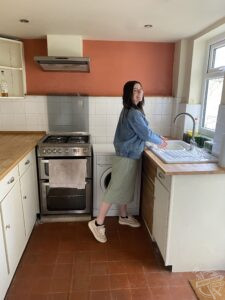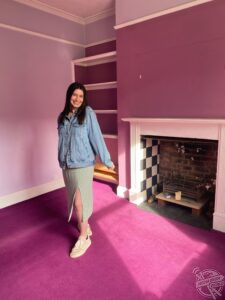By Abigail Marlow
THIS SUPERSAVING woman has revealed exactly how she put aside £20K for a deposit on her home thanks to savvy saving techniques and side hustles that she developed during the pandemic.
Medical Information Researcher Amy Ward (24) from Manchester had more time on her hands when working from home for one and a half years during the pandemic and decided to explore her personal financial goals, including her dream of purchasing her first £217K two bedroom terraced home.
Fuelled by the desire to become a home owner, Amy threw herself into side hustles and became a savings queen.
Side hustles are a hot topic within the financial community with people flocking to money saving outlets to raise extra funds.
From survey sites to cat sitting, Amy partakes in a variety of side hustles which has resulted in her income being topped up with a healthy £7K each year, making a great addition to her existing £20K savings.
She hopes that her methods can increase her annual side hustle earnings from £7K to £10K very soon.
“I’ve saved £20K since starting my Instagram page and budgeting methods, which helped massively when my partner and I came to buy our first house,” she said.
“I’ve been able to save quite a lot over the last few years, a combination of the lockdown, budgeting methods, side hustles and mindset have helped me get there.
“One of my main side hustles is completing online survey sites.
“It’s a really convenient way to make extra money, as all you need is a phone and internet connection.
“I like completing surveys to make money as I can do this when suits me best, I commonly complete surveys when travelling via public transport or when I’m watching TV in the evenings.

“There are well-paid survey sites such as AttaPoll, Measure, Prolific and Y Live.
“One of my other side hustles is cat sitting. This is such a lovely way to make money.
“I get paid to look after cats when their owners are away.
“This usually involves topping up food and water bowls, having a cuddle and playing with the cats.
“I have some recurring customers which is great as it means I’ve created some great relationships with the cats I visit.
“Finally, a new side hustle of mine is creating and selling digital products. I have made several products such as savings trackers and even an eBook discussing survey sites as a side hustle.”
Amy’s £7K side-hustle earnings can be broken down as follows:
£3K from referrals and sign up offers
£1.5K from survey sites
£800 from cat sitting
£700 from daily spins/cash saving apps
£600 from cash back sites
£400 from digital products
Amy is also keen to follow some budgeting trends, especially ‘zero based budgeting’ and sinking funds and reveals just how easy these are to put into our daily lives.
“One budgeting method that I really enjoy using is ‘zero based budgeting’ . This is when your income – your expenses – your spending: is zero.
“This budgeting method ensures that all of your money is accounted for, it encourages you to save money each pay day and essentially ‘pay yourself first’ which I really like.
“This method has allowed me to save more money each month and I think this method is responsible for a large amount of my savings over the last few years – potentially around an extra £10K more than I used to.
“I’ve also used sinking funds which are a great budgeting method, sinking funds are small pots that you keep separate from your main bank accounts and savings.
“The idea of sinking funds is that you put away small amounts of money each month into different categories.
“For example, instead of having a super expensive December with Christmas taking place you can create a Christmas sinking fund and save all year round.
“I have been doing this since January and save £50 per month into my Christmas sinking fund, by December I will have around £550 to spend on all things Christmas.
“Using sinking funds alone I have saved around £5k over the last few years.”
As a result of her starting her IG page Amysbudgeting, Amy has forged a 10K community of likeminded individuals who love exchanging budgeting tips and tricks.
“Other money I saved mainly came from side hustle earnings,” she said.
“It honestly amazes me that I’ve been able to save so much, I never thought this would be attainable a few years ago,” she said.
“I have plenty of savings goals, but the majority of the money will be put into the house and maybe the occasional holiday and treat here and there.”
Amy was paying £15 per month for unnecessary phone insurance and was over-spending on broadband. Rectifying these costs means that Amy is now able to save an extra £300 a year.
Due to their thriftiness, Amy and Gregory (26), her partner of four years achieved one of their financial goals, recently saving enough to purchase their first home. She explains how you can do the same.
“When we first met at university neither of us were the best with money,” she said.
“This has certainly changed over the years we’ve been together.
“Saving for our first house really helped us get in control of our finances and motivated us to explore new avenues for making some extra money.
“We’re definitely aligned in our money saving goals and also the way we control our finances which is really nice and motivating.
“By using various methods such as budgeting, savings challenges and having lifetime ISAs my partner and I were able to save for our house deposit and all the additional fees required when buying a house.

“Using a lifetime ISA was a great help during our house buying process and any first-time buyers should 100% consider doing the same, the government matches 25% of the money you save.
“You can save up to £4,000 per tax year, meaning you can get up to £1,000 for ‘free’ from the government.
“The house buying process was completely new to us and was a bit overwhelming at times. We were viewing houses at the end of the lockdown and soon realised how competitive the market was.
“We offered on several houses and got offers rejected, with one house selling for 50K over the asking price.
“We bought a lovely Victorian mid terrace house, built in 1880 so filled with a lot of history and character, it is two bedrooms and lots of other great features like a basement and separate living room and dining room.
“We put down a 10% deposit on the house with a purchase price of £217,000.
“We saved extra money for renovations such as new bathroom and kitchen and general remodel and style.
“We originally over offered on the house but after we got the survey results back we negotiated the purchase price and took off money that was quoted for the required works – even saving money when buying the house.
“We’ve got some builders coming next week to start off the work but plan to do most of the work ourselves.
“Needless-to-say, we have been spending plenty of hours watching DIY videos.

“I will be documenting how much money we spend on our house renovation over on my Instagram page.”
For those overwhelmed at the thought of beginning their budgeting journey, Amy offers some advice.
“I suggest as a first step it’s best to have a look at your spending habits,” she said.
“A simple way of doing this is creating a budget, writing down your income and all your outgoings. Here you can see what you spend and identify if you can cut back on any of these expenses.
“Clearly seeing your income and outgoings can help you work out how much you can save each month.
“Another suggestion is to give savings challenges a go; there’s a whole range of savings challenges out there for any income level.
“There’s the penny saving challenge where you save 1p on day one, 2p on day two and so on, from this alone you can save over £600 in one year.”
ENDS










